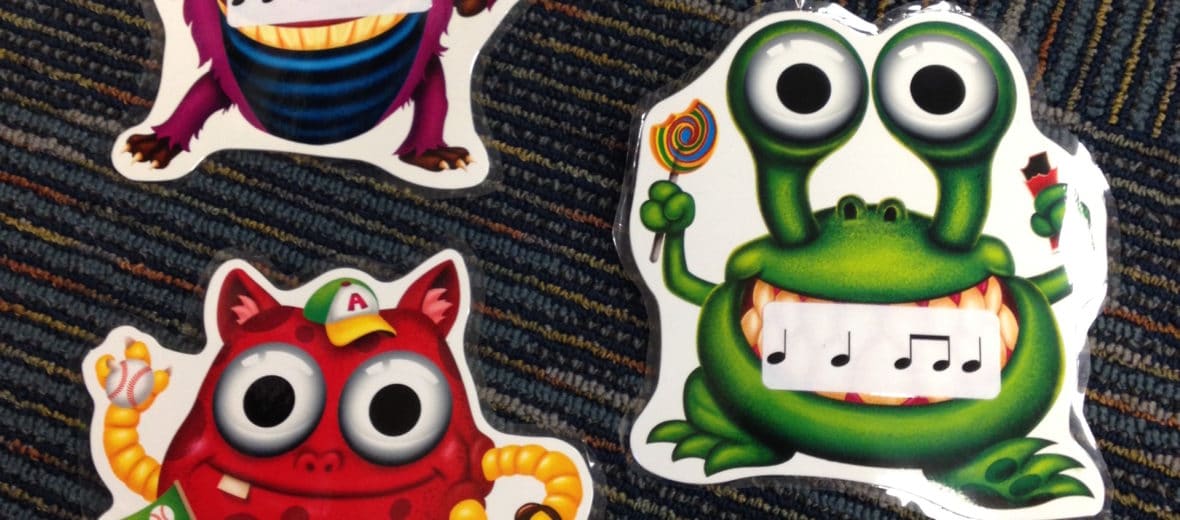
Music Monsters – Composition Game for 3rd Grade and Beyond
This was a fun game that I happened onto with my third graders late last semester. I found these super cool die-cut monsters at the Dollar Tree and knew that I wanted to make something fun with them. I’m working on expanding my center materials/composition games because I’ll have my third graders working in centers soon when we hit our recorder unit (more to come with that soon). This game came so naturally once I decided what I wanted to do with the materials.
I got the idea for this from one of the amazing lead elementary music teachers in my district, my good friend Nikki Wiarda. Nikki did an inservice for my district’s elementary music teachers a month or two ago about how she uses centers in her classroom, what she does to set them up, the way she organizes and so on. Nikki mentioned that she got really frustrated writing down rhythms again and again on die cuts and also trying to write out the treble clef and staff over and over again on hand outs and manipulatives. So, she got the amazing idea to print a bunch of musical staves, simplified staves, and other basic things on a sheet of return address labels. This saved her loads of time! Once she had the basic staff printed out she could go back and input any notes she wanted by hand.
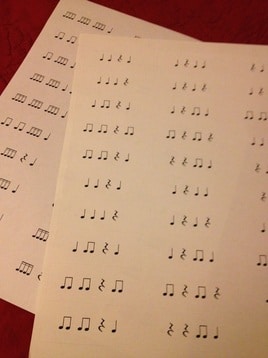 I thought this was a fantastic idea and decided to do something similar to help with a rhythm/composition game that I had in mind! Thus, the composition monsters were born! I sat down and worked out a bunch of four beat rhythm sets to print on return address labels. My third graders started reading sixteenth notes last semester so I made sure to make lots of labels that had sixteenth notes (along with other things they already knew: half notes, half rests, quarter notes, quarter rests, eighth notes). Each address label would have one measure full of notes/rests that added up to four beats.
I thought this was a fantastic idea and decided to do something similar to help with a rhythm/composition game that I had in mind! Thus, the composition monsters were born! I sat down and worked out a bunch of four beat rhythm sets to print on return address labels. My third graders started reading sixteenth notes last semester so I made sure to make lots of labels that had sixteenth notes (along with other things they already knew: half notes, half rests, quarter notes, quarter rests, eighth notes). Each address label would have one measure full of notes/rests that added up to four beats.
Once I had my rhythms ready I ran to the printer and printed off all the rhythms on their labels; one four beat measure per label. The super fun part was peeling off the rhythm stickers and sticking them onto the monsters. I made four big sets of monster cards with something like 36 rhythms/monsters in each. Since I divide each class into four sections/four instrument families (see this post for how I divide and conquer my classes and reinforce instrument families at the same time!) I made sure to write a letter on the back of each monster so that I could sort/differentiate them at the end of the class.In the end I only had to sit down and write enough rhythm measures to fill up one sheet of address labels. Because I have four different groups/families in each class I printed that one sheet of labels four times and used the same set of rhythm measures for each family. The monsters come in sets of 36 monsters at the Dollar Tree, more than enough monsters for the activity I needed. Each family would get a pack of monsters that were all their own.
Monster Composition Game
 I told my class of 3rd graders that there were monsters invading the music room! To get rid of monsters you have to compose a four measure composition. But because the monsters don’t want to go away they’re going to try and stop you! They’re going to try and mess you up! Your job is to do such a good job of composing that you can get rid of all your monsters!
I told my class of 3rd graders that there were monsters invading the music room! To get rid of monsters you have to compose a four measure composition. But because the monsters don’t want to go away they’re going to try and stop you! They’re going to try and mess you up! Your job is to do such a good job of composing that you can get rid of all your monsters!
Each kid starts off with a white board, a marker, an eraser, and three monsters. They get to choose whatever monsters they want. I send the kids off to sit with their families and give each family a set of monsters. The kids pick their three monsters from the set of 36 monsters that their family gets.
I show kids how to make four measures on their white board and then tell them that monsters are going to take over three measures. They put their monsters in whatever order they want. Maybe the monsters will take over measures 1, 2, and 4. That means that they have to copy the rhythm that they find on their monster into those three measures. The measure that isn’t covered by a monster THEY have to fill with their own four beat composition. Once they’ve copied their monsters rhythms and filled in the last measure with their own composition they bring the board and their monsters to me.
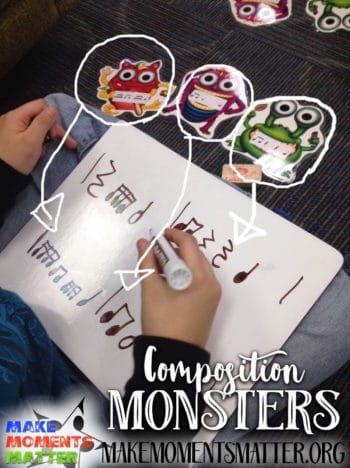 I check their work. I quickly make sure they’ve copied correctly from the monster’s rhythms and I match up which monster goes where. I actually put the monster on top of their “copied” measure so that I can clearly see what’s left for me to check. I make sure they have only four beats, no more or less, and that the notes are written correctly. I love this moment because it gives me a chance to work one-on-one with kids and remind them “You have too many beats! What can we take out?” or “You don’t have four sixteenth notes, but you have two sets of eighth note pairs! Don’t forget to add that extra bar or else you’re not making sixteenth notes, you’re making eighth notes in disguise.” and so on.The game is wonderful because it gives the kids a chance to copy rhythms that I know are right and then it gives them a shot at doing their own work. In the beginning they only have to compose one measure on their own. If they come up and check and their measure of composition is okay then I let them get rid of one of their monsters. The kids go back to their spot with two monsters, erase their board, and start the process again.
I check their work. I quickly make sure they’ve copied correctly from the monster’s rhythms and I match up which monster goes where. I actually put the monster on top of their “copied” measure so that I can clearly see what’s left for me to check. I make sure they have only four beats, no more or less, and that the notes are written correctly. I love this moment because it gives me a chance to work one-on-one with kids and remind them “You have too many beats! What can we take out?” or “You don’t have four sixteenth notes, but you have two sets of eighth note pairs! Don’t forget to add that extra bar or else you’re not making sixteenth notes, you’re making eighth notes in disguise.” and so on.The game is wonderful because it gives the kids a chance to copy rhythms that I know are right and then it gives them a shot at doing their own work. In the beginning they only have to compose one measure on their own. If they come up and check and their measure of composition is okay then I let them get rid of one of their monsters. The kids go back to their spot with two monsters, erase their board, and start the process again.
The second time through they are responsible for composing TWO measures instead of one. They can still copy their two monsters but they have a wider margin for error since they have two new measures to come up with. This works out well pedagogically because they have to compose only one measure at first and then once they’ve had some experience they do two measures, and then three. It gives the advanced kids a chance to work quickly. The kids who need help only have to focus on one measure initially and gradually take on more responsibility.
 The goal of the game is to get rid of all of your monsters. Some/most kids can do it. It depends on how much time you leave for the game, how well your students know how to compose, and how fast you can check measures and hand back the boards to them. For the first class I did this with I got back-logged with kids waiting for me to check their measure. Then as I figured out what I could do to speed up the process things got a lot faster.And what happens for those advanced kids who finish quickly and are bored? I give them the chance to pick three new monsters or I tell them that they can compose four measures all on their own with no monsters. Either way they have to come back and check only once after that. This allows me to focus on the kids who really need the help and gives those advanced kids a chance to keep working on their own (they’ve got a task, but I don’t have to worry about them).
The goal of the game is to get rid of all of your monsters. Some/most kids can do it. It depends on how much time you leave for the game, how well your students know how to compose, and how fast you can check measures and hand back the boards to them. For the first class I did this with I got back-logged with kids waiting for me to check their measure. Then as I figured out what I could do to speed up the process things got a lot faster.And what happens for those advanced kids who finish quickly and are bored? I give them the chance to pick three new monsters or I tell them that they can compose four measures all on their own with no monsters. Either way they have to come back and check only once after that. This allows me to focus on the kids who really need the help and gives those advanced kids a chance to keep working on their own (they’ve got a task, but I don’t have to worry about them).
All in all this was a super fun game for the kids, super great review of composition/sixteenth notes, and super easy to create! The hardest part was probably sitting down and figuring out what rhythms to put on what labels. Once that was done it was a click, print, stick, and go! Oh, and I laminated. ALWAYS LAMINATE!
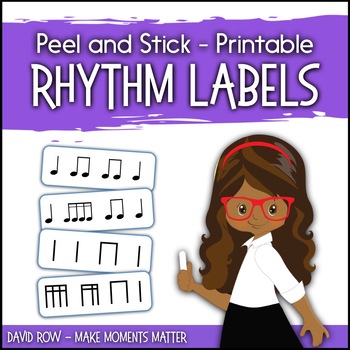 And here’s where it gets easier for YOU! When I went through to write out all the measures of rhythms I decided to really go for it. I wrote out measures from easy (quarter notes and eighth notes only) to more advanced (quarter note, eighth note, quarter rest) and on (quarter note, quarter rest, eighth notes, half note, half rest) and on and on until I got to syncopation, dotted notes, sixteenth note/eighth note pairs. Each page of rhythms that I created I copied down in stick notation so that you could click, print, and peel in standard or stick notation. And once I finished a whole set of 4/4 measures I went back and did a set of 3/4 measures.This really does save SO MUCH TIME when you want to create manipulatives and games. Think about all the games and hand outs you could make with a sheet of address labels and a quick trip to the Dollar Tree for die cut shapes! The possibilities are endless.
And here’s where it gets easier for YOU! When I went through to write out all the measures of rhythms I decided to really go for it. I wrote out measures from easy (quarter notes and eighth notes only) to more advanced (quarter note, eighth note, quarter rest) and on (quarter note, quarter rest, eighth notes, half note, half rest) and on and on until I got to syncopation, dotted notes, sixteenth note/eighth note pairs. Each page of rhythms that I created I copied down in stick notation so that you could click, print, and peel in standard or stick notation. And once I finished a whole set of 4/4 measures I went back and did a set of 3/4 measures.This really does save SO MUCH TIME when you want to create manipulatives and games. Think about all the games and hand outs you could make with a sheet of address labels and a quick trip to the Dollar Tree for die cut shapes! The possibilities are endless.
Check out my Teachers Pay Teachers store for this awesome download! You can get both the 4/4 document and 3/4 document in one bundle! Ya’ll know that I’m stingy and wouldn’t pay a ton for something like this, so it’s not a very expensive download. Let me know how it works for you, if it needs modified, and what YOU create with it!

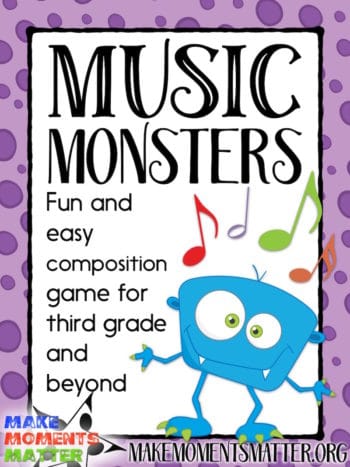

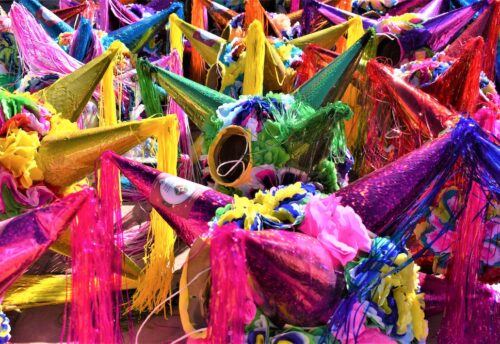
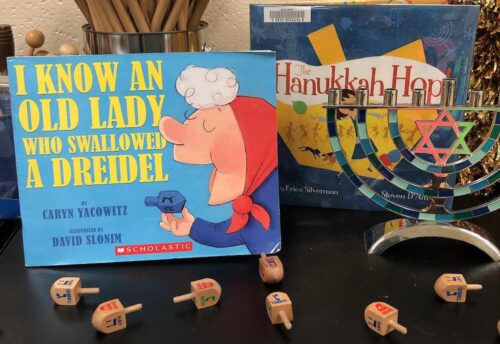
16 Comments